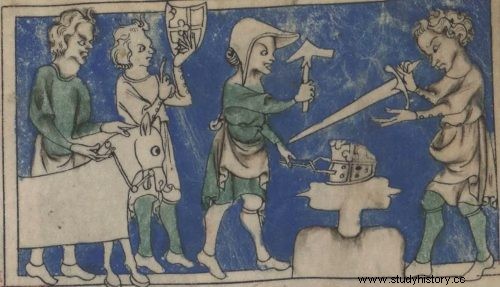Earth coal
Although it seems unlikely to us, air pollution problems in human societies began almost a thousand years ago.
As early as the 9th century, coal (as opposed to charcoal), found on the northeast coast of England, was burned as fuel. Soon the air reeked of filthy fumes, making breathing intolerable in London. A few centuries later, King Edward I (1272-1307), then monarch of England, banned its use in his kingdom. As the area around London was deforested, households turned to burning cheap coal. The ban in 1307 on the use of coal was twofold:the smell that affected the air but also its impact on human health.
 (1)
(1)
"The air there is polluted over a wide area...to the detriment of the bodily health of the citizens," the king told his bailiffs and sheriffs. In his order, he said he wanted to “take precautions to ensure the safety of the prelates and his subjects.” The king ordered the use of alternative materials such as wood.
As early as the 13th century, restrictions were imposed on the burning of coal to prevent the health risks of air pollution.
The king's successor, Edward II (1307-1327) would go further:those found polluting the air with coal smoke were to be put under question. But the order was diluted when Richard II (1377-1399) took over. It adopts a moderate position and seeks to limit its use through taxation. Subsequently, the reign of Henry V (1413-1422) saw the creation of a commission to regulate the entry of coal into London.

At that time, very little scientific information was available on the health hazards of air pollution. But it is remarkable how such drastic measures have been taken to control it. Today, it is well known that burning coal releases particulates, sulfur dioxide, nitrogen oxides and other hazardous substances, all of which are harmful to human health.
The beginning of pollution atmospheric All the strict measures that were taken against the combustion of coal were, however, rendered ineffective in the 16th century. To meet the needs of a growing population, forest areas were cleared. As there was no more wood to meet the fuel needs, the burning of coal became essential. Moreover, with the onset of the industrial revolution, the number of fuel-based industries grew rapidly. And the smoke from poorly designed chimneys began to pollute the air.

Endemic problem, Elizabeth I (16th century) also attests to this, by her comments and banned the burning of coal in London, but only when Parliament was sitting.
I am very pained and annoyed by the taste and the smoke (…) The air is infected and corrupted at the peril of those who frequent … and inhabit these places (Elizabeth I of England).
Transportation was by rail, with coal-fired steam engines, which darkened the neighborhood. As late as 1950, it was reported that in Glasgow, Scotland, three tons of soot per acre per year were pulverized by steam engines. And while the poor lived in filth, the rich migrated to the hills or made weekend homes in the countryside. Queen Elizabeth I's court physician invented a way to remove the sulfur content, but the process was neither cheap nor reliable.
With the spread of the Industrial Revolution, air pollution problems also spread to other countries. The first half of the 20th century saw the revival of efforts to control air pollution.
In 1952, a terrible fog descended on London. Particle levels reached up to 4 billion g/cum and became trapped in the Thames Valley for several days. The death rate increased fivefold in the days following the increase in pollution levels. Although the exact cause of the poisoning is still not known, sulfur dioxide is thought to be the root cause. The incident had such an impact on health in the UK that the European Parliament decided to put an end to it.
My sources:
Particles in Our Air:Concentrations and Health Effects, by Richard Wilson and John D Spengler .
